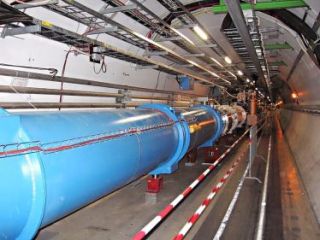Jun 23 2015
Neutrinos are subatomic particles produced by the decay of radioactive elements. They are the only known particles that interact only though the weak interaction, a fundamental interaction of nature. Lacking an electric charge, neutrinos can travel though the Earth unimpeded. Indeed, they make up the universe. Nonetheless, they are poorly understood. They have a very small mass – much smaller than all the other elementary particles – and why this is so is also not clear.
 Tunnel of the Large Hadron Collider at CERN. Photo credit: Julian Herzog.
Tunnel of the Large Hadron Collider at CERN. Photo credit: Julian Herzog.
University of California, Riverside scientists are working on the Compact Muon Sollenoid (CMS) experiment in the Large Hadron Collider (LHC) at CERN. A team led by John Ellison, a professor of physics and astronomy, has been examining CMS data to look for evidence of a “Majorana neutrino.” Ellison’s team led the search and developed most of the analysis techniques. The team also performed most of the analysis. The research paper can be found here. http://arxiv.org/abs/1501.05566
The Majorana neutrino is a heavy kind of neutrino. Its mass is tied together with the mass of an ordinary or “Standard Model” neutrino, the Standard Model being a comprehensive theory that explains the interactions between all fundamental elementary particles, accounting for most measurements to date. Majorana neutrinos also have the property that they are their own antiparticle. As a consequence, they can decay to either muons or antimuons which have negative or positive charge, respectively.
“We do not know if heavy Majorana neutrinos exist, but if they do the Standard Model neutrino mass could be explained by their interaction with the heavy Majorana neutrino via the Higgs boson,” Ellison said. The Higgs boson is an elementary particle in the Standard Model. “This is called the seesaw mechanism because via this interaction the mass of the regular neutrino is inversely proportional to the mass of the heavy neutrino, so a very heavy neutrino produces a tiny mass for the regular Standard Model neutrino.”
Majorana neutrinos have not been observed. This is because previous accelerators have not had enough energy to produce them.
“Very high energy collisions are needed to create very massive particles,” Ellison explained. “The LHC is now running with almost double the energy of the last run – 13 TeV vs 8 TeV center-of-mass energy.”
Will this new LHC run help scientists like Ellison finally observe the Majorana neutrino?
“Possibly,” Ellison said, “but since we know neither the mass nor the coupling, we cannot say for sure. Should we observe it, it could explain the tiny neutrino mass as well as indicate physics beyond the Standard Model.”
Besides Ellison, the following scientists with UCR affiliations are involved in the search for the Majorana neutrino at CERN: Ferdinando Giordano, a former graduate student Ellison’s; and Brent Yates, a graduate student in Ellison’s lab who is working on new CMS data.
The Office of Science in the Department of Energy supported the UCR scientists in the research.